Le Mans: vrooms with a view
A look at the role played by Hotel de France at Le Mans – a sanctuary for drivers and their cars
Words Damien Smith / Taken from Motor Sport, February 2015
The past is present in any trip to Le Mans for purist pilgrims to the 24 Hours. We paused ours en route at Rouen to discover the glorious old Grand Prix circuit, retraced the original Le Mans course that led into the town itself, then lingered over the racing relics in the museum at the track’s entrance. Now we have another must-see diversion that will lure us for an hour or an afternoon during Le Mans week in June.
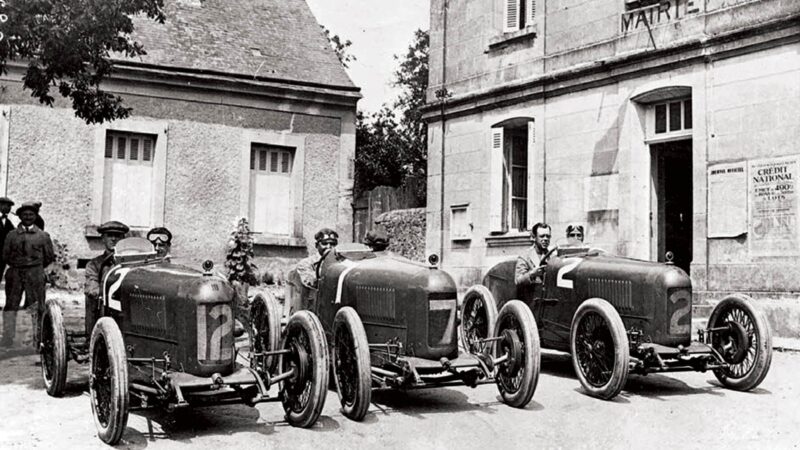
Pictured in Semblançay, Sunbeam’s drivers visited the hotel in 1923
The Hotel de France has always been there. But now it is restored to its charming Art Deco best that made it a popular haven for race teams from the 1950s to the ’80s. It echoes to the days when drivers took refuge in its serenity, mechanics prepped Aston Martins, Triumphs, Ferraris and even Porsche 917s in its courtyards – and then drove them on the public road ready for action on the Circuit de la Sarthe.
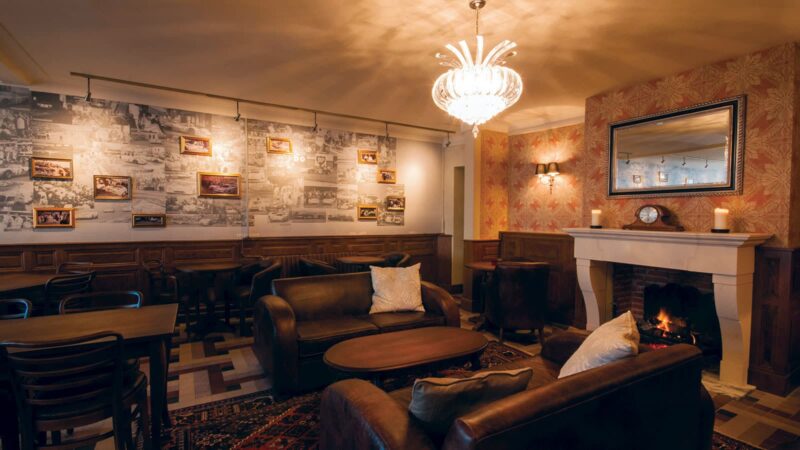
Renovated interior
The hotel reflects simpler days now romanticised by the passing of time, and its resurrection is all down to the enthusiasm of an Englishman abroad.
We paid a visit last July on the Friday before the Le Mans Classic meeting, picking up the scenic D304 to gallop the 25-odd miles south-east of the circuit to the picturesque village of La Chartre-sur-le-Loir. The sweeping road offered a flavour of how Le Mans used to be before the addition of Armco barriers and run-off areas, and in the thoroughbred Ferrari F12 Berlinetta we’d borrowed for the trip the drive alone was worth the trip.
Outside the hotel, the Place de la République was packed as gendarmes corralled a wide range of classics into the square. The F12 doesn’t count – yet – but I was directed to reverse park the Ferrari into the side courtyard. We recreated scenes from ancient photos when Ford GT40s squeezed in the same spot, and if it wasn’t for the stark modernity of the F12 you’d find it hard to believe that 50 years have passed.
Inside, every table was taken in the bustling dining area where the walls are plastered with fantastic photos, some of which we’ve reproduced here. There’s even specially commissioned wallpaper that tells the history of the hotel, which opened for business in 1905. Motor racing has a strong heritage in this part of France. Henry Segrave, who won the 1923 French GP in his Sunbeam on a road circuit north of Tours, dined at the hotel. Its reputation for food led John Wyer to the hotel in 1953. He was so enamoured, he made it his home during subsequent Le Mans weekends through the Aston Martin, GT40, 917 and Gulf Mirage years. Drivers such as Derek Bell, Jacky Ickx, Phil Hill, Jochen Rindt, Bruce McLaren, Carroll Shelby, Stirling Moss, Jackie Stewart and Mario Andretti also stayed regularly.
Decades later, businessman and racing enthusiast Martin Overington was bowled over by the charm of the place when a friend suggested they stay there for the 24 Hours in 2001. “We went back every year thereafter,” he says. “But I noticed over a period of five or six years that the hotel was dying off. Not to put too fine a point on it, the guys who were going there in the 1950s, ’60s and ’70s were falling off the perch… and there was no one younger feeding in from the bottom. I found this rather sad.”
“I noticed the hotel was dying off. I found that rather sad”
Overington would prove his credentials as a potential new owner in suitable fashion. “I bought a Bentley Blower six years or so ago and started racing it at Le Mans Classic, and I guess it must have been four and a half years ago that I finished the race and thought it would be a great idea to drive the Blower back to the hotel, with oil spewing out of it! But it got there. It was then that someone said, ‘Look, you really need to do something about this place, you’re the right person to do it’. And after a couple of bottles of good red wine I decided it was a fantastic idea, put the wheels in motion and made an offer. It got accepted, and then the panic set in about what I’d done!

A home to travelling teams, from Triumph to TVR, De Tomaso and even Aston Martin
“It took two to three years to go through the rigmarole of physically buying it. It was fraught with various issues and we eventually completed the sale on December 10 last year [2013]. But then the biggest challenge was renovating the place to a standard that wouldn’t alienate our regulars or the guys that made their annual trip over for the 24 hours, while attracting younger Le Mans fans and bringing back the locals who’d left the hotel over a period of time.”
“After a couple of bottles of good red wine I made an offer. Then the panic set in about what I’d done!”
Having spent so long working on the sale completion, Overington didn’t waste time on a project that was a “passion” rather than a fortune generator. It helped that he’d made his money in exactly this business.
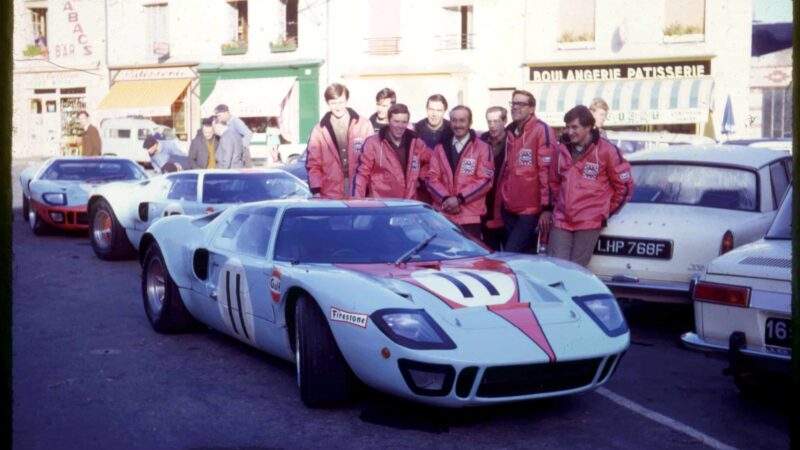
Bryan Miur/Jackie Oliver Ford GT40 in 1968
“We spent a lot of money on it and completely stripped the hotel,” he says. “All the rooms have been refurbished down to the last stitch. Everything is new: electrics, light fittings, plumbing. We shut it on New Year’s Day [2014], and then had three weeks before our first guests began to arrive. We used English labour because that’s my business: I build hotels and restaurants. So we imported everything, which we cleared with the French before we began because I was concerned they might boycott me. I spoke to all the local artisans and tradesmen in the village, they understood what we were doing and they let us get on with it. In fact they and the mayor were all incredibly supportive of us.”

The twin Gulf GR8s that finished first and third in 1975, the winner at the rear
That in itself sounds remarkable. “It is unusual, but I kind of made myself known to them over a period of about three years by driving French cars. I’ve got a 1952 2CV, Citroën DSs and a Citroën H Van which is used by the hotel. I became obvious to the village as an eccentric Englishman who loved French cars. I try to speak French too, and they got used to me. They’ve been fantastic. If there’d been another French hotel and I was trying to start a new one, it might have been a different matter. But the village appreciates the role the hotel plays within the local economy, so they’ve been supportive.”

Raymonde and Francis Pasteau pose with DP214s in 1963
Overington’s research into the hotel’s history continues to uncover fascinating snippets. The children of Presidents John F and Bobby Kennedy stayed here, and so did Steve McQueen. “Having been owned by the same family for 100 years the heritage they had built up was perhaps overlooked,” says Overington. “For the family, the hotel was their living, but to me it’s more than that. It’s a special place and it is that history which makes it unique.”
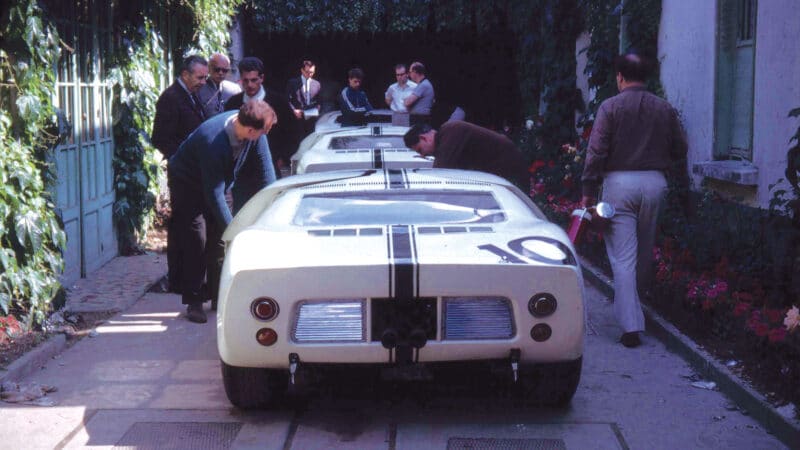
Early Ford GT adventures in 1964
The wonderful photos we present here were taken by the hotel’s former owner Noel Pasteau, and it was his son Francis who agreed to sell to the ‘eccentric Englishman’. “Monsieur Pasteau was a bit miffed when he first found out,” says Overington. “He didn’t know until the end of last year; they’d kept it quiet from him. I found him in the car park looking rather forlornly at the hotel in January when we were refurbishing it, so I marched him into the hotel to introduce him to everyone. When he saw what we were doing, and why, he gave us his blessing. He now visits for his morning coffee every day, which makes it all worthwhile. Even Jacky Ickx popped by unannounced and gave his approval!”
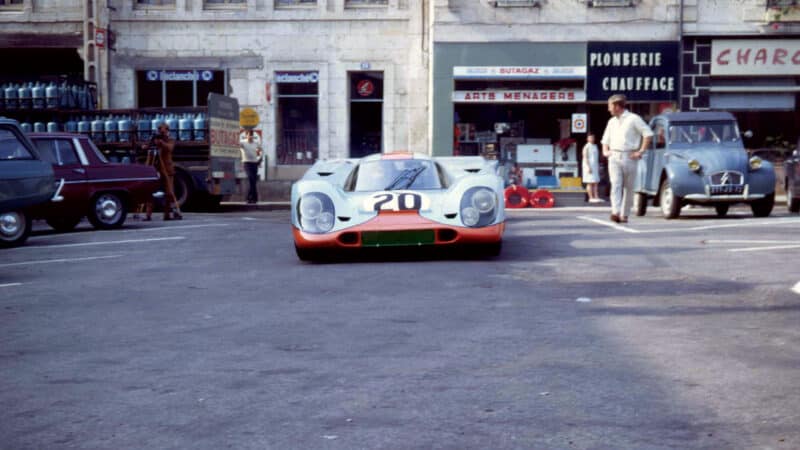
The sight of a Porsche 917 on a public street with a 2CV, standard…

The square at
La Chartre was a sight in 1971
For an Englishman to ingratiate himself so completely into a rural French community suggests Overington could switch careers and join the UN. But the locals have been won over because he’s always kept them at the heart of his plans. “The temptation is to make it a mecca for motoring, but it absolutely isn’t,” he insists. “It’s a local hotel in a local village for 50 weeks of the year, and quite frankly for most of its customers its association with motor racing is not the overriding factor. The rooms in the main hotel are named after drivers, but the only thing corresponding to that is a small portrait with a description. It’s not overtly about motor racing.”
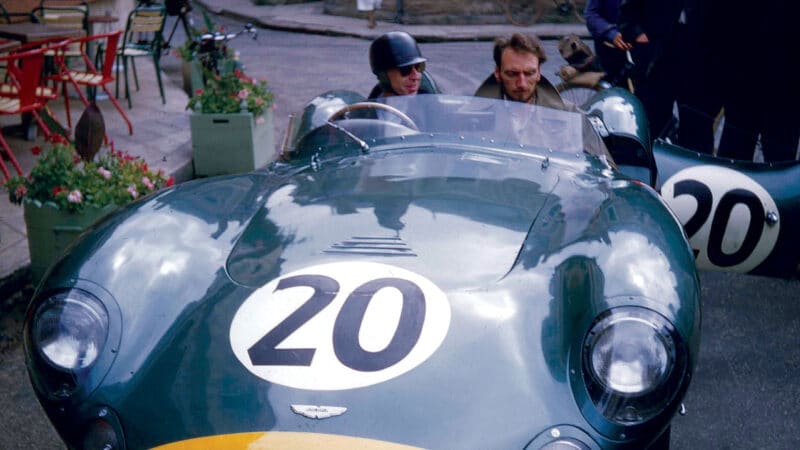
Tony Brooks and Noël Cunningham-Reid’s Aston Martin DBR1 hits the road in 1957
Still, from what we saw the Hotel de France is already a ‘destination’ for car nuts, whether they drive Bentleys or Subaru Imprezas, and plans are brewing for special motoring events involving car clubs. Last season Derek Bell drove Overington’s Kenwood-sponsored Porsche 962 on the D304 as a lovely nod to the past, thanks to help from the local gendarmerie, and we can expect more of the same soon, perhaps with a Gulf theme.
“Derek Bell drove a Porsche 962 on the D304 as a nod to the past”
But as Overington says, the hotel needs to function beyond race weekends at Le Mans and for people who don’t necessarily love cars. “My long-term desire is to increase trade through the off-season, from November to March,” he says. “Certainly it’s a great destination for winter with open fire places and the village is beautiful that time of year. We’ll put on wine-tasting tours and visits to châteaux. And it’s less than two hours from Caen.”
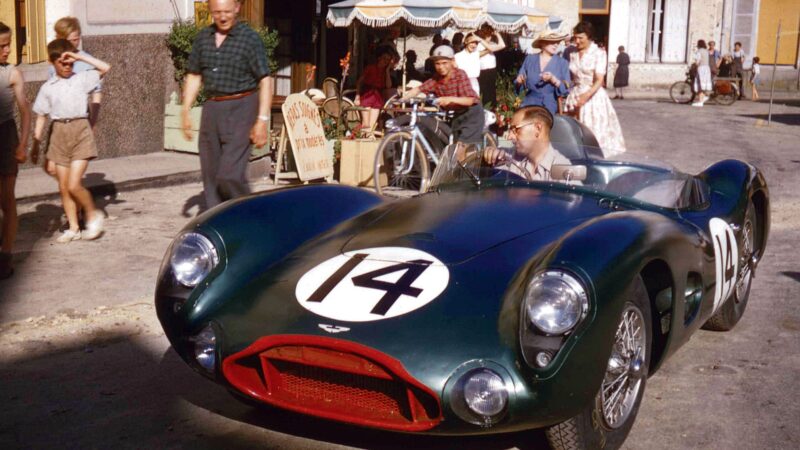
The Brooks/Parnell Aston DBR1 in 1956, with Raoul Pasteau looking on
You can bet the Place de la République will be mobbed on Le Mans weekend in 2015, and demand for rooms will be off the scale. Another option to enjoy the atmosphere at the hotel would be to camp a short walk away with travel experts Speed Chills, which is running one of its superb sites in La Chartre for the second time. A pleasant and civilised alternative to the usual Le Mans campsites is guaranteed.
Beyond the 24 Hours, a visit at a quieter time of year would have its own charms, as Martin suggests.
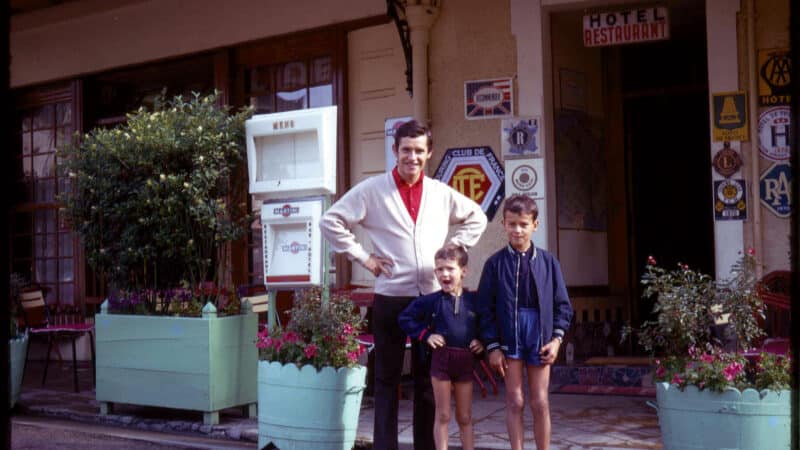
Jacky Ickx was a fan
The countryside, towns and villages are a delight in this part of the world, just on the northern edge of the Loire valley. Perfect for a romantic weekend away – with only a tasteful and convenient hint of a motor racing link. We’d recommend it.
Essential travel guide
Where to stay
It’s possible that you might fancy taking in a round of the Peugeot RCZ Cup on the Bugatti Circuit, but the chances are that the 24 Hours will be your primary target. Just as at a grand prix, prices escalate when there’s a captive audience in town, but local residents let spare rooms on a B&B basis, the tram network connects the circuit to city hotels and camping abound. You can also find packages that include Channel crossing, race ticket and four nights in a nearby chateau. That said, it’s Le Mans: you should be prepared to sleep al fresco, on Saturday evening at least.
Route tips
By road, it’s better to avoid Paris – although that is an option if you want to watch locals forcing Peugeot 407s into parking spaces big enough for only a Twingo. Instead, take the A16 west from Calais and thread via Boulogne towards Rouen on the A28 and then south on the A11 to Le Mans – allow about 3hrs 45min for the trip. The alternative is to travel to Paris by air or train, then catch a TGV from Montparnasse to Le Mans: that bit takes about an hour, less than half the time it would take to complete the same journey by car. If you happen to own an executive jet, there is a convenient airstrip directly opposite the circuit. If ever you should have the privilege of arriving by plane, it’s quite something to see the familiar asphalt silhouette from above.
Interesting diversions
The Musée des 24 Heures du Mans is worth a visit when you get there, but Rouen is the most obvious place for motor sport tourists to pause. Racing ceased at the French GP’s five-time home in the early 1990s, all circuit furniture was demolished in 1999 and its signature – a cobbled hairpin – is now asphalt. It is still possible to drive most of a lap, though, and in parts you can see the crumbling remains of what used to be grandstand steps. From Rouen, head south-west towards Elbeuf,
locate the D938 and dream.



